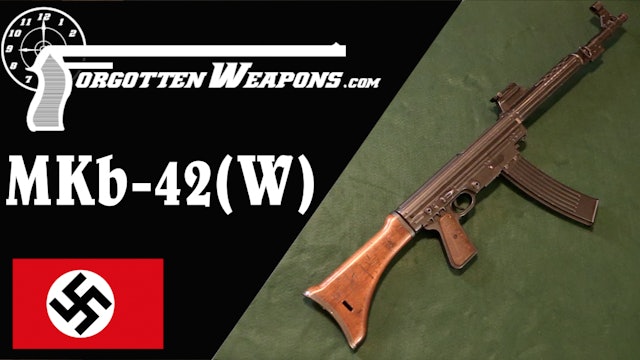-
Navy 7.62mm NATO Conversion M1 Garand - Mk2 Mod1
When the M14 rifle was developed to replace the M1 Garand, is was met with some uncertainty by the US Navy. The Navy had a lot of things to spend money on, and not a lot of need for a replacement for the M1 Garand (note that the Marine Corps did adopt the M14 despite being a component of the Navy...
-
Mystery Mauser - Haitian? Czechoslovakian? Or Not?
This Mauser is one that I simply have not been able to definitively identify. It is marked “Haiti 1957” and “CZ 29 - 53”, serial numbered 10, and chambered for an 8mm cartridge (probably 8x57 Mauser). However, the rifles known to have been purchased by Haiti were FN model 24/30 short rifles in .3...
-
GIGN's MR73 Sniper Revolver in .357 Magnum
Courtesy of the French Ministry of the Interior, we have a chance to take a look at an authentic GIGN sniper model MR73 revolver today. GIGN is the elite intervention element of the French Gendarmerie, akin to GSG9 in Germany or the FBI Hostage Rescue Team in the US. Back in the 1970s, the servic...
-
Shooting the H&K MP5K Operational Briefcase
Heckler & Koch's "Operational Briefcase" is a clever system for covert carry of a submachine gun without the need to conceal such a large type of weapon under bulky clothing. By putting the gun into a briefcase, they gave security personnel a way to blend right into the business and executive typ...
-
Confederate Morse Carbine: Centerfire Cartridges Ahead of Their Time
George Morse of Baton Rouge patented a design for a remarkably modern centerfire cartridge and breechloading rifle action in 1856 and 1858, using a standard percussion cap as a primer. This was coupled with a gutta percha washer for sealing and a rolled brass cartridge body that was strong and ro...
-
MKb-42(W) - The Sturmgewehr That Never Was
When the German military first requested rifles in the new 8x33mm Kurz cartridge, there were two companies that provided designs. One was Haenel, who would eventually win the competition. The other was Walther, who submitted this rifle - the MKb-42(W). Where the Haenel gun fired from an open bolt...
-
The Mini-14: A Cost-Effective Scaled-Down M14
The Ruger Mini-14 is certainly not a “forgotten” weapon, but I think there are some valuable insights to be taken from it. As a company, Ruger has an outstanding track record of making not flashy and exciting guns, but rather guns that are economical and dependable. The Mini-14 is an excellent ex...
-
MG-34: The Universal Machine Gun Concept
The MG34 was the first German implementation of the universal machine gun concept - and really the first such fielded by any army. The idea was to have a single weapon which could be used as a light machine gun, heavy machine gun, vehicle gun, fortification gun, and antiaircraft gun. The MG34 was...
-
The MG-15: A Flexible Aircraft Machine Gun Pushed into Infantry Service
The MG-15 was the first standard flexible-mounted aircraft machine gun adopted by the Luftwaffe in the 1930s. Both it and the MG-17 are evolved from a Rheinmetall/Solothurn design which would also become the Austrian and Hungarian M30 infantry light machine guns. As used by the Luftwaffe, the MG1...
-
Mauser C98: The System That Cost Paul Mauser an Eye
One of Paul Mauser's lifelong projects was the design of a semiautomatic rifle for the German military. He would go through a multitude of different designs searching for something that would be sufficiently reliable, durable, and simple - and ultimately he would never fulfill the goal. But his e...
-
DeserTech 7.62mm MDR Teardown
The DeserTech MDR ("Micro Dynamic Rifle") has been in the works for several years now, after being initially announced at SHOT Show in 2014, if I recall correctly. While it was probably prematurely unveiled, the rifle as it stands today looks to be remarkably well designed. It is one thing to des...
-
Before the Lewis Gun was the McClean Automatic Rifle
Samuel McClean was a medical doctor from Iowa who began tinkering with firearms designs in 1889, and formed the McClean Arms Company in 1896. He was an intelligent and talented designer, but never quite managed to get a gun good enough for military acceptance. His work included bolt actions rifle...
-
MC58: A USMC Semiauto Trainer 22 for the M14
When the USMC adopted the M1 Garand in 1942, they decided they would like to have a new semiautomatic training rifle in .22 rimfire to go along with it. Eugene Reising, working for Harrington & Richardson, promptly produced a semiauto .22 LR version of his military submachine gun to fulfill that ...
-
Semiauto FAMAS F1 Rifle (MAS .223)
The French FAMAS was one of the first bullpup rifles to be adopted and built in large numbers by a military power. It was adopted by France in 1978 at right about the same time as the Steyr AUG was being adopted by the Austrian military. Bullpup rifles offered a short overall length without sacri...
-
Steyr M95 Straight-Pull Semiauto Conversion
This rifle is a Steyr M95 straight-pull carbine that has been converted into a semiauto by adding a gas piston under the barrel connected to the bolt carrier, and an extension to the stock and receiver for the bolt to travel in. The pistol grip was added so that the trigger group could remain unc...
-
Mateba MTR-8
The MTR-8 was Emilio Ghisoni's first revolver design, predating the more popular and better known Mateba semiauto revolvers and the Chiappa Rhino. The MTR-8 was designed for competition shooting, and made in a variety of calibers and configurations, including long carbine versions, different barr...
-
MAS 49-56 in a 2-Gun Match
A while back, I ran a 2-Gun match on my own with my MAS 49-56 (and a plain Glock 19), including the original APX L806 optic. It was not a particularly complex match, but it was fun to give the 49-56 a whirl.
Takeaways:
- The 10-round magazines of the MAS family are definitely a hindrance i...
-
Shooting the MAS-38 Submachine Gun: Second Try
Take 2! I have some ammunition loaded up for me by awesome viewer Cameron, and we're going to try it out in the MAS-38 submachine gun. This is loaded hot enough to properly cycle Mle 1935 pistols, unlike the ammunition available from Reed's and Buffalo Arms. However, it is a bit shorter than the ...
-
France's Super-Light 50mm Modele 37 Grenade Launcher
A new very light and portable mortar to replace the V-B rifle grenade was one of the facets of the French plan for rearmament and modernization after World War Two. The concept for the weapons that would become the L.Gr. Mle 37 was first requested in 1924 - but like so almost all the other parts ...
-
MAS-36 LG48: A Grenade Launcher for the Bolt Action Infantry
Once it became apparent that the MAS-36 was going to be used in a substantial amount of frontline combat (to the contrary of its intended role as a reserve or secondary rifle), it became important to provide it with grenade launching capability. The French military really liked rifle grenades as ...
-
MAS-36: The Backup Rifle is Called to Action
There is a common assumption that the MAS-36 was a fool's errand from the outset - why would a country develop a brand new bolt action rifle in the mid 1930s, when obviously semiautomatic combat rifles were just on the cusp of widespread adoption? Well, the answer is a simple one - the French wer...
-
John Martz Custom P38s: Babies, .45s, and .38 Supers
John Martz was a WWII US Navy veteran who spent a career in metalworking before turning his gunsmithing hobby into a full time occupation in the 1960s. He is best known for his custom Luger pistols, but also worked extensively with the P38. Today we are looking at an assortment of his custom P38s...
-
John Martz Custom Luger Pistols - Babies, Carbines, and .45 ACP Conversions
John Martz was a WWII US Navy veteran who spent a career in metalworking before turning his gunsmithing hobby into a full time occupation in the 1960s. He is best known for his custom Luger pistols, and today we have a selection of them to take a look at. They fall into three main categories - ca...
-
WW Marston Breechloading Pistol and Leather-Base Cartridge
William Walker Marston was born in 1822, and would spend his career as a gunsmith and gunmaker in New York City. He produced a wide variety of firearms, including pepperboxes, multi-barrel derringers, percussion revolvers, and the breechloading single-shot pistol which we are looking at in this v...

























